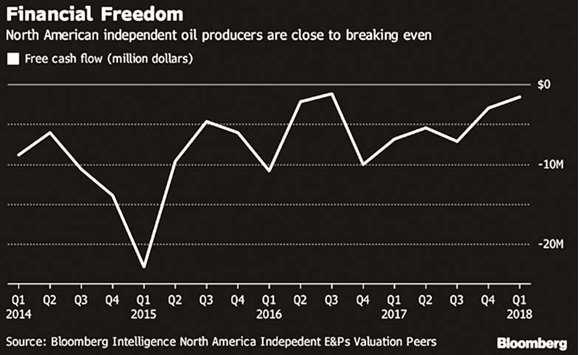The shale boom’s back in full swing, with fracking crews the busiest since 2014. The novelty this time around: Oil executives stressing their prudence, along with their production.
The combination of surging output, oil prices at three-year highs and spending under control means that the shale patch – which has notoriously burnt more cash than it makes as investors bankroll their expansion – got closer to a milestone in the first-quarter: Positive free cash flow. As oil rises above $70 a barrel, the outlook for the coming quarters looks even brighter.
It’s a shift that came with the help of new high-tech well systems, and at the insistence of investors pushing payback over growth. Here are five key takeaways from the first quarter to track moving forward: Production is thriving
EOG Resources Inc and Pioneer Natural Resources Co are among producers that posted record output, while keeping capital expenditures in check.
But how can they keep growing without overspending?
Producers have sought to cut costs since prices crashed more than three years ago, but those efforts can only go so far. It’s mainly better technology that’s allowing them to get more from each well without blowing their budgets.
Pioneer, in a recent presentation, offered insight into how its high-tech wells are delivering at a faster rate, a theme repeated over and over again in earnings calls. Devon Energy Corp said it completed the two highest-rate wells in the Delaware section of the Permian in its 100-year history, helping it to a 20% production boost.
Almost living within their means
Buybacks, dividend increases and a cap on capital expenditures. Oil executives couldn’t keep from crowing about their thriftiness while producing record amounts of product, and how their efforts can be a benefit to both their shareholders, and to continued growth.
The numbers back them up, showing a pretty good rise in free cash flow, starting from the end of 2016.
The oil rally’s flip side: Hedging
A big risk facing some producers now is the amount of wrong-way bets on oil prices that they hold. When crude markets slumped, explorers used hedging contracts to lock in payments for future barrels that could now turn sour as futures trade above $70 a barrel.
Wood Mackenzie Ltd’s Andrew McConn estimates top producers will lose $7bn on their hedging contracts in 2018.
The reality on the ground
To make record production a reality, oil-service providers are sending a growing number of fracking crews to shale fields to blast the oil-rich layers of rock with water, sand and chemicals.
But for the service providers, that hasn’t translated into better profits yet.
The rush to respond to heightened demand has inflated costs for materials like sand and has triggered transportation bottlenecks and labour shortages. All that has weighed down on their first-quarter results. Schlumberger Ltd, the world’s biggest oilfield service provider, and Halliburton Ltd, the top fracker, have both promised investors things will improve. If that means increasing prices for their services, costs will rise for producers.

.
